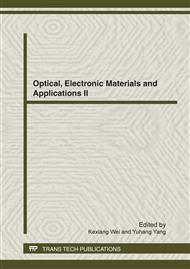[1]
M. H. Chen and B. Schmeiser: Performance of the Gibbs, Hit-and-Run, and Metropolis samplers. Journal of Computational and Graphical Statistics. 2: 251-272. (1998).
DOI: 10.2307/1390645
Google Scholar
[2]
G. S. Fishman: Monte Carlo: concepts, algorithm, and applications. Springer. New York. (1995).
Google Scholar
[3]
A. Gelmen, G. O. Roberts and W. R. Gilks: Efficient Metropolis jumping rules. Bayesian Statistics. 5: 599-607. (1996).
Google Scholar
[4]
C. J. Geyer: Markov Chain Monte Carlo maximum likelihood. Computing Science and Statistic: The 23th symposium on the interface. 156-163. (1991).
Google Scholar
[5]
W. Hardle, M. Muller, S. Sperlich and A. Werwatz: Nonparametric and Semiparametric Models. Springer. New York. (2004).
Google Scholar
[6]
J. D. Hart: Nonparametric Smoothing and Lack-of-Fit Tests. Springer. New York (1997).
Google Scholar
[7]
W. K. Hastings: Monte carlo sampling methods using markov chains and their applications. Biometrika. 57: 97-109. (1970).
DOI: 10.1093/biomet/57.1.97
Google Scholar
[8]
F. M. Liang, G. H. Liu, and R. J. Carrol: Advanced Markov Chain Monte Carlo methods: learning from past samples. Wiley, New York. (2010).
DOI: 10.1002/9780470669723
Google Scholar
[9]
F. M. Liang and H. W. Wong: Real-parameter evolutionary Monte Carlo with application to Bayesian mixture models. Journal of the American Statistical Association. 95: 121-134. (2001).
DOI: 10.1198/016214501753168325
Google Scholar
[10]
J. S. Liu: Monte Carlo strategies in scientific computing. Springer. New Youk. (2001).
Google Scholar
[11]
N. Metropolis, A. W. Rosenbluth, M. N. Rosenbluth MN,A. H. Teller, and E. Teller: Equations of state calculations by fast computing machines. Journal of Chemical Physics. 21: 1087-1091. (1953).
DOI: 10.1063/1.1699114
Google Scholar
[12]
W. Shao, G. B. Guo, F. Y. Meng and Y. J. Gai: Efficient proposal distribution in Metropolis-Hastings algorithm using a B-splines technique. Manuscript. (2011).
Google Scholar
[13]
W. Shao, G. Q. Zhao and L. P. Zhu: Mixture normal proposal for Metropolis-Hastings algorithm. Manuscript. (2012).
Google Scholar
[14]
G. O. Robert, A. Gelman andW. R. Gilks: Weak convergence and optimal scaling of random walk Metropolis algorithm. The Annals of Applied Probability. 7: 110-120. (1997).
DOI: 10.1214/aoap/1034625254
Google Scholar


